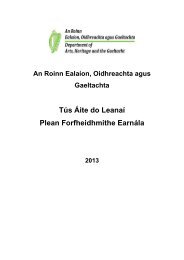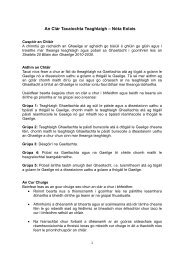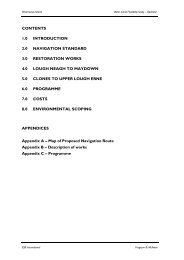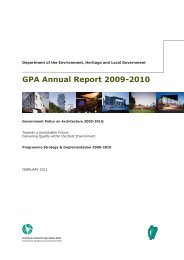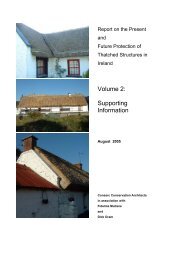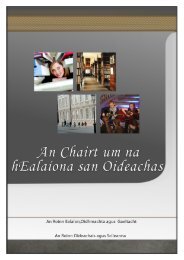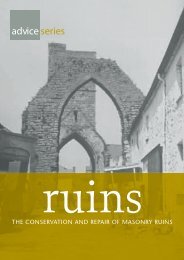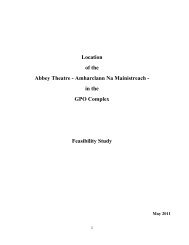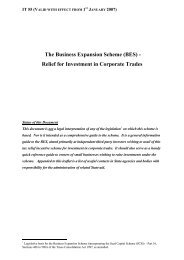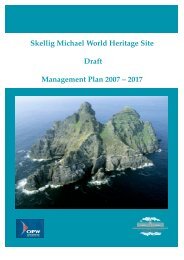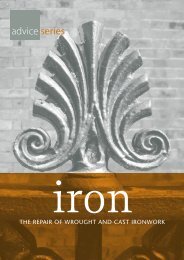A Guide to the Repair of Historic Roofs - Dublin City Council
A Guide to the Repair of Historic Roofs - Dublin City Council
A Guide to the Repair of Historic Roofs - Dublin City Council
You also want an ePaper? Increase the reach of your titles
YUMPU automatically turns print PDFs into web optimized ePapers that Google loves.
ROOFS A GUIDE TO THE REPAIR OF HISTORIC ROOFSDRY ROT: SERPULA LACRYMANSDry rot is less common in ro<strong>of</strong>s than wet rot;none<strong>the</strong>less it can, in some instances, cause seriousproblems. Dry rot requires damp, humid conditions <strong>to</strong>thrive. The name ‘dry rot’ is misleading as this funguswill survive only where timber moisture content is inexcess <strong>of</strong> 20 per cent. An advanced outbreak <strong>of</strong> dry rotis easily distinguished from wet rot in that it producesan abundance <strong>of</strong> white mycelia – a fluffy mass <strong>of</strong>cot<strong>to</strong>n wool-like threads. Mature fruiting bodies arerust red in colour and rust-coloured spore dust onnearby surfaces can be an indication <strong>of</strong> its presence.Timber that has been <strong>the</strong> subject <strong>of</strong> dry rot attack willhave lost its structural integrity and look as if it hasbeen formed in separate cubes with cracks runningacross <strong>the</strong> grain. This cuboidal cracking is a distinctivecharacteristic <strong>of</strong> dry rot infected timber.The conservative method <strong>of</strong> treating dry rotconcentrates on removing <strong>the</strong> source <strong>of</strong> water andimproving levels <strong>of</strong> ventilation <strong>to</strong> <strong>the</strong> ro<strong>of</strong> space. This isknown <strong>to</strong> halt <strong>the</strong> spread <strong>of</strong> dry rot and leave <strong>the</strong>fungus unable <strong>to</strong> thrive and reproduce. Leakingflashings and gutter linings should be repaired andappropriate pointing or rendering carried out <strong>to</strong>adjoining masonry. The removal <strong>of</strong> timber affected bydry rot should be limited <strong>to</strong> that timber which isstructurally decayed and any small remaining partsthat need <strong>to</strong> be removed <strong>to</strong> allow a structural repair.There is no need for wholesale removal <strong>of</strong> soundtimber in an area <strong>of</strong> dry rot outbreak, nor is extensivechemical irrigation <strong>of</strong> masonry adjoining <strong>the</strong> outbreakalways advisable, due <strong>to</strong> <strong>the</strong> <strong>to</strong>xic nature <strong>of</strong> someproducts and <strong>the</strong> need <strong>to</strong> avoid introducing moremoisture in<strong>to</strong> <strong>the</strong> fabric <strong>of</strong> <strong>the</strong> building. New timbersused in repair works should be pre-treated andisolated from masonry by wrapping <strong>the</strong> ends in adamp-pro<strong>of</strong> membrane. Local fungicidal treatment <strong>of</strong><strong>the</strong> timber immediately surrounding <strong>the</strong> rot outbreakmay be appropriate <strong>to</strong> prevent future outbreaks. Thistreatment will need <strong>to</strong> be <strong>of</strong> a deep penetratingformulation, or else injected in<strong>to</strong> pre-drilled holes in<strong>the</strong> timber. An independent timber treatmentspecialist should be consulted <strong>to</strong> advise onappropriate action.The fruiting bodies <strong>of</strong> <strong>the</strong> serpula lacrymans funguscan be identified by <strong>the</strong>ir rust or orange colour,usually with a white edgingINSECT INFESTATIONIn Ireland, <strong>the</strong>re are four types <strong>of</strong> insect capable <strong>of</strong>maintaining an infestation in building timbers.These are:> Furniture beetle (commonly known as‘woodworm’)> Wood-boring weevil> Death watch beetle> House longhorn beetleThe last two species are extremely rare and have onlybeen found in a handful <strong>of</strong> buildings in this country.FURNITURE BEETLE OR ‘WOODWORM’(ANOBIUM PUNCTATUM)The furniture beetle can be a serious pest in buildingtimbers. It lays its eggs in crevices in <strong>the</strong> sapwood <strong>of</strong>both hardwoods and s<strong>of</strong>twoods. The larvae hatchwithin weeks and spend <strong>the</strong> next few years (betweenone and five years, depending on conditions)burrowing through <strong>the</strong> sapwood <strong>of</strong> <strong>the</strong> timber. Thelarvae <strong>the</strong>n make <strong>the</strong>ir way back up <strong>to</strong> just below <strong>the</strong>surface <strong>of</strong> <strong>the</strong> timber and form a pupal chamber. Theypupate for about eight weeks. The adult beetlesemerge between late May and August. Active furniturebeetle infestation can be recognised by <strong>the</strong> presence<strong>of</strong> sharp-edged 1 <strong>to</strong> 2mm diameter emergence holeswith interiors <strong>the</strong> colour <strong>of</strong> freshly cut timber and freshwood dust. Particularly in <strong>the</strong> summer months, deadbeetles 5 <strong>to</strong> 6mm long can be seen near or on affectedtimbers.51



